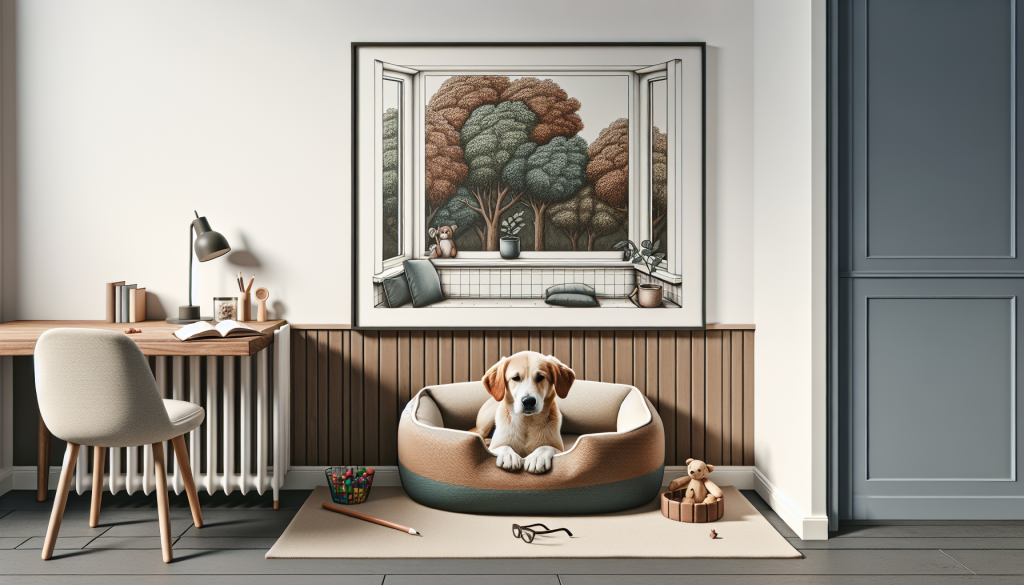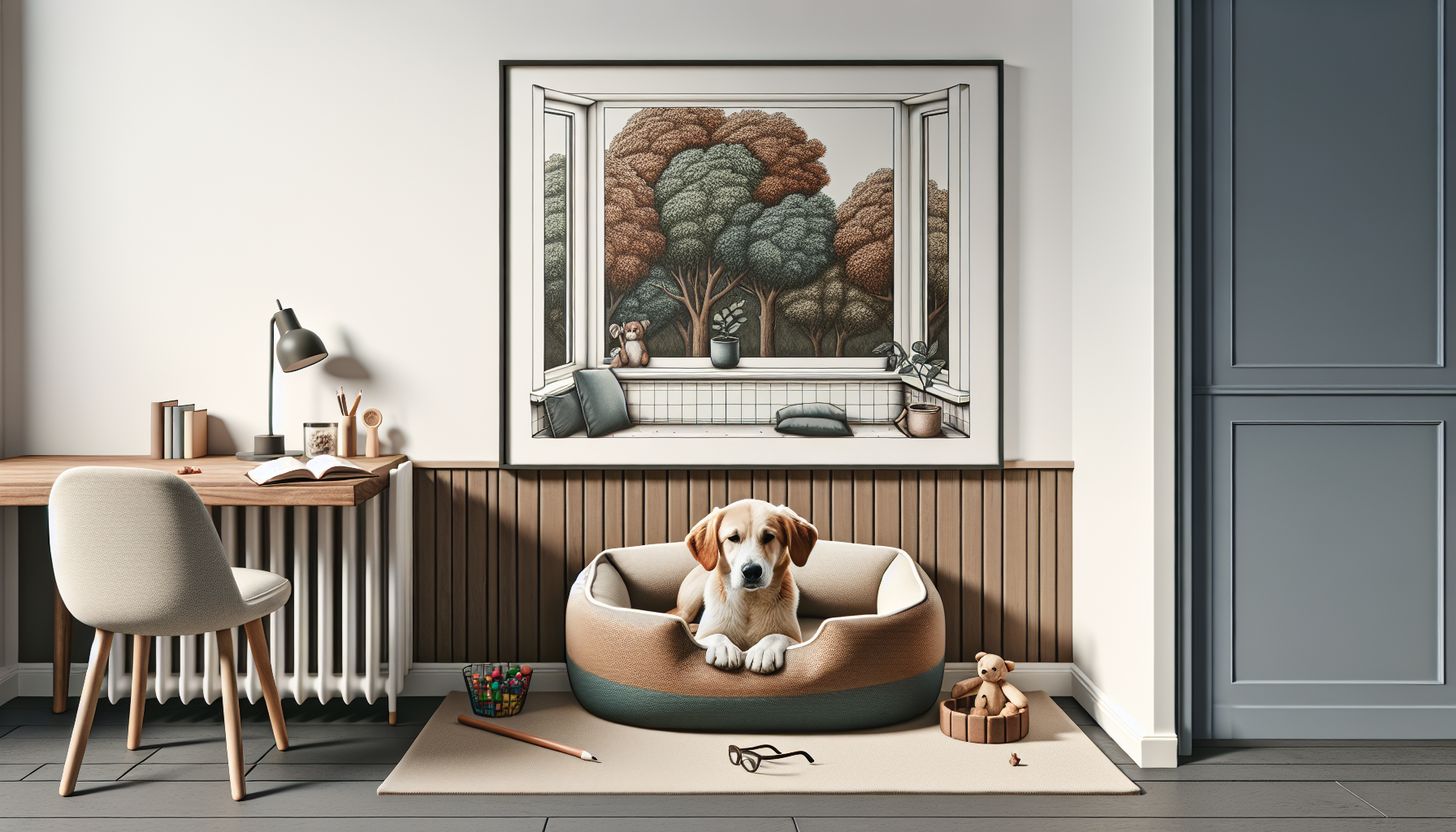Finding the perfect spot for your furry friend’s bed can make all the difference in their comfort and happiness. After all, just like us, dogs need their own cozy sanctuary to unwind and relax. But the question remains: where should a dog bed be placed? Ensuring that the location is both practical and appealing to your pup is crucial for them to truly feel at ease. In this article, we will explore some smart and strategic options that will help you find the ultimate resting place for your canine companion. Whether it’s a sunny spot by the window or a quiet corner of the living room, let’s discover the best spot for your dog’s bed together.

Factors to Consider
When deciding where to place a dog bed in your home, there are several factors that you should consider. These factors include the size of your dog, the temperature and climate in your area, the noise level of your home, the amount of traffic and activity in the area, the proximity to your family, and the accessibility of the location.
Size of the Dog
The size of your dog is an important factor to consider when determining where to place their bed. Larger dogs may require more space, so you’ll need to ensure that the area you choose can accommodate their size comfortably. Additionally, larger dogs may produce more heat, so it’s important to choose a location that allows for proper ventilation to keep them cool.
Temperature and Climate
The temperature and climate in your area should also be taken into account when deciding on a location for your dog’s bed. If you live in a colder climate, it may be beneficial to place the bed near a source of warmth, such as a radiator or fireplace. On the other hand, if you live in a warmer climate, you should choose a cooler area away from direct sunlight to prevent overheating.
Noise Level
Considering the noise level in your home is crucial when determining the best spot for your dog’s bed. Dogs, just like humans, need a quiet and peaceful environment to rest comfortably. Avoid placing the bed in areas where there is a lot of noise, such as near the television or in a busy hallway. Instead, opt for quieter areas where your dog can relax and unwind without disturbances.
Traffic and Activity
The amount of traffic and activity in a particular area should also be taken into account. If your home is bustling with activity and there is constant foot traffic, it may be best to place your dog’s bed in a more secluded area where they can have some peace and quiet. This will help them feel safe and secure in their personal space.
Proximity to Family
Dogs are social animals and often want to be close to their human family members. It’s important to place their bed in an area where they can still feel connected to you and the rest of the family. Consider placing their bed in a location that allows them to be near the family’s living spaces, such as the living room or a common area, so they can still be part of the daily activities.
Accessibility
The accessibility of the location is another crucial factor to consider. Make sure the chosen area is easily accessible for your dog, especially if they are older or have mobility issues. Avoid placing their bed on high surfaces or in areas that require a lot of effort to reach. A location that is easily accessible will promote independence and ensure that your dog can comfortably access their bed whenever they need to rest.
Indoor Placement
When it comes to indoor placement for your dog’s bed, there are several factors to consider.
Room Choice
Choosing the right room for your dog’s bed is important for their comfort and well-being. Consider a room where they spend a lot of time or a room that is quiet and cozy. Bedrooms or living rooms are often good options, as they provide a sense of security and closeness to their human family members.
Avoiding Drafts
Drafts can be uncomfortable for dogs, especially during colder months. Avoid placing their bed in areas where there is a draft, such as near windows or doors. This will help prevent them from feeling cold and ensure they can rest comfortably without any discomfort caused by chilly air.
Distance from Doors and Windows
While it’s important to avoid drafts, it’s also crucial to consider the distance from doors and windows. Placing your dog’s bed too close to a door or window may expose them to excessive noise, bright lights, or sudden gusts of wind. Find a balance between avoiding drafts and providing a quiet and peaceful environment for your furry friend.
Proximity to Family Activities
Dogs are social animals and often want to be part of the family’s activities. Consider placing their bed in an area that allows them to feel connected and involved in what’s happening around them. If you spend a lot of time in the kitchen, for example, placing their bed nearby will allow them to be near you while you cook or socialize.
Comfort and Coziness
Ensuring that your dog’s bed is comfortable and cozy is essential for their overall well-being. Choose a location that provides a soft and supportive surface for them to rest on. Consider the type of flooring in the area and add extra padding if needed. Additionally, placing their bed in an area with soft lighting and a warm ambiance will create a soothing environment that promotes relaxation.
Avoiding High-Traffic Areas
High-traffic areas, such as hallways or busy rooms, may not be the best choice for your dog’s bed. These areas can be disruptive and may not allow your dog to fully relax and rest. Opt for quieter areas with less foot traffic to provide your furry friend with a serene environment where they can sleep peacefully.

Outdoor Placement
When it comes to outdoor placement for your dog’s bed, there are additional factors to consider.
Weatherproofing
When choosing a location for your dog’s outdoor bed, it’s important to ensure that it is weatherproof. Select a bed that is designed to withstand the elements and place it in an area where it will be protected from rain or snow. This will prevent the bed from becoming wet and uncomfortable for your dog.
Shade and Shelter
Providing shade and shelter is crucial when placing your dog’s bed outside. Choose a location that offers natural shade from trees or install a canopy or a shelter to protect your dog from direct sunlight and extreme weather conditions. This will ensure that your dog can enjoy their outdoor space comfortably and safely.
Protection from Predators
Safety is paramount when placing your dog’s outdoor bed. Make sure the location you choose is secure and provides protection from predators. If there are wild animals or strays in your area, consider placing the bed in an enclosed space or installing a fence to prevent any potential threats from reaching your furry friend.
Avoiding Puddles and Mud
Dogs love to explore, but wet and muddy areas can make their bed dirty and uncomfortable. Avoid placing the bed in areas prone to puddles or mud to keep it clean and dry. Choosing a location with a solid and well-drained surface will ensure that your dog’s outdoor bed stays in good condition and provides a comfortable resting place.
Distance from Gardens or Plants
If you have a garden or plants in your outdoor space, it’s important to consider the distance between your dog’s bed and these areas. Some dogs may be tempted to dig or chew on plants, which can be harmful to both your dog and your garden. Placing the bed at a safe distance will prevent any unwanted interactions and ensure the well-being of both your pet and your plants.
Avoiding Direct Sunlight
While it’s important for dogs to have access to fresh air and natural light, direct sunlight can be excessive and uncomfortable. Avoid placing your dog’s bed in areas where it will be exposed to prolonged direct sunlight, as this can lead to overheating and discomfort. Instead, choose a shaded area where your dog can enjoy the outdoors without the risk of overheating.
In conclusion, when deciding where to place your dog’s bed, it is important to consider their size, the temperature and climate, the noise level, the traffic and activity in your home, the proximity to your family, and the accessibility of the location. Indoor placement should take into account room choice, drafts, distance from doors and windows, proximity to family activities, comfort and coziness, and avoiding high-traffic areas. Outdoor placement should consider weatherproofing, shade and shelter, protection from predators, avoiding puddles and mud, distance from gardens or plants, and avoiding direct sunlight. By carefully considering these factors, you can provide your furry friend with a comfortable and safe place to rest and relax.
